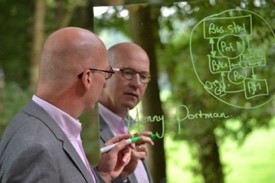Sensemaking in the Agile Forest
SERIES ARTICLE
By Henny Portman
The Netherlands
Introduction
Do you multitask, taskswitch or monotask? If you talk on the phone while driving, you could say you are multitasking (you may wonder if that’s wise). But working on two user stories at once as an agile team member is not feasible. As soon as you stop working on the first, unfinished user story and start working on the second user story you speak of task switching.
Monotasking
So, what is monotasking in an Agile team? Suppose a complete agile team takes a week to complete a feature. And all team members play a role in the delivery of that feature. The team is now tasked with delivering three similar features. If the team picks up and completes these three features in a row (sequentially), the team is done after three weeks. After delivery of the first feature the customer can already get value by using this feature.

Task-switching
And task-switching? If this same agile team is instructed to work on all three features at the same time, it would seem that after three weeks the team could have completed all three features. However, nothing could be further from the truth. Each time the entire team switches from one task to another, it takes time. Delivery will be closer to four weeks than to three weeks.

A problem you run into today, you can’t just put it out of your mind when you start working on another task tomorrow. This will keep you busy and thus will be detrimental to your effectiveness. Moreover, to start with another task, you must go back to where you left off last time and that takes time. Therefore, you are less efficient.
Experiment: counting from 1 to 26
There are two tasks. One task involves writing down the numbers from 1 to 26. The other task involves writing down the letters A through Z. During training sessions, I have frequently conducted the following experiment. I split the group in two.
The first group employs monotasking. This group writes on a sheet of paper the numbers 1 through 26 in sequence. When they are done with that, the same group writes, in a second column, the letters A through Z under one another. As a result, you now see written 1 A, 2 B, 3 C through 26 Z.
The second group continually switches tasks and writes 1 A, 2 B, 3 C through 26 Z in sequence.
Result? The second group takes at least 40% longer…
More…
To read entire article, click here
Editor’s note: This is the 10th article in a series by Henny Portman, one of the world’s leading authorities on “agile”. Based in The Netherlands, Henny coined the term “agile forest” in 2019 to describe the many agile frameworks that have emerged over the last 20 years. This series is intended to help readers better understand the agile concept, navigate through the ‘underbrush’ and more successfully apply whichever framework is selected for their projects.
How to cite this article: Portman, H. (2022). Multitasking, task-switching or monotasking; Sensemaking in the Agile Forest series, PM World Journal, Vol. XI, Issue X, October. Available online at https://pmworldlibrary.net/wp-content/uploads/2022/10/pmwj122-Oct2022-Portman-Multitasking-task-switching-or-monotasking-agile-forest-series-10.pdf
About the Author

Henny Portman
The Netherlands
![]()
Henny Portman, owner of Portman PM[O] Consultancy and was partner of HWP Consulting, has 40 years of experience in the project management domain. He was the project management office (PMO) thought leader within NN Group and responsible for the introduction and application of the PMO methodologies (portfolio, program, and project management) across Europe and Asia. He trains, coaches, and directs (senior) programme, project and portfolio managers and project sponsors at all levels, and has built several professional (PM(O)) communities.
Henny Portman is accredited in a variety of qualifications, including P3O, PRINCE2, MSP, MoP, PRINCE2 Agile, AgilePM, AgilePgM and AgileSHIFT trainer and an SPC4 SAFe consultant and trainer. He is a P3M3 trainer and assessor and PMO Value Ring Certified Consultant (PMO Global Alliance). On behalf of IPMA, he assesses mega and large projects for the IPMA Project Excellence Award. In addition to this, he is an international speaker, author of many articles and books in the PM(O) field, and an active blogger. More at hennyportman.wordpress.com
Henny can be contacted at henny.portman@gmail.com
To view other works by Henny Portman, visit his author showcase in the PM World Library at https://pmworldlibrary.net/authors/henny-portman/









